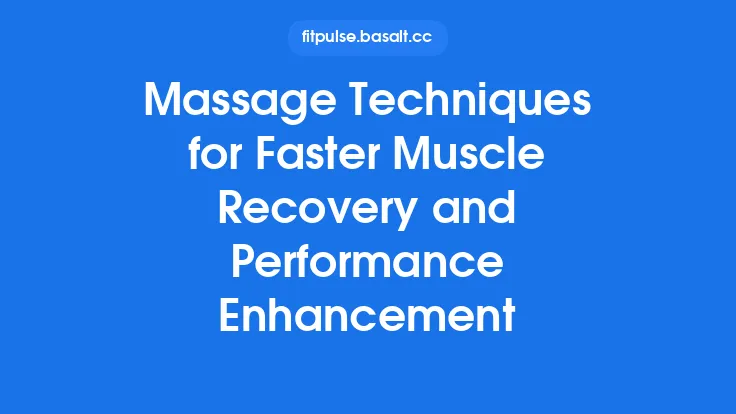Recovery is the often‑overlooked half of any successful hypertrophy program. While the gym provides the stimulus that drives muscle protein synthesis, the time spent outside the weight room determines whether that stimulus translates into genuine growth or, conversely, into chronic fatigue and overtraining. By treating recovery as a systematic, science‑backed component of your training plan, you can accelerate muscle hypertrophy, preserve joint health, and keep your nervous system responsive for the next workout. Below is a comprehensive guide to the most effective recovery strategies, organized into actionable sections that you can integrate into any strength‑training routine.
Sleep Optimization
Why sleep matters
During deep (slow‑wave) sleep, growth hormone (GH) secretion peaks, creating a hormonal environment that favors muscle protein synthesis (MPS) and glycogen replenishment. Simultaneously, cortisol—a catabolic hormone—drops to its lowest daily levels, reducing muscle breakdown. Even a single night of <6 h sleep can blunt MPS rates by up to 30 % and impair insulin sensitivity, both of which are detrimental to hypertrophy.
Key variables
| Variable | Recommendation | Rationale |
|---|---|---|
| Total duration | 7–9 h per night (individual variation may push the upper end) | Guarantees sufficient time for multiple complete sleep cycles (≈90 min each) and maximizes GH spikes. |
| Sleep timing | Align bedtime and wake time with your circadian rhythm (e.g., 10 pm–6 am) | Consistency stabilizes melatonin release, improves sleep architecture, and reduces sympathetic nervous system activity. |
| Sleep environment | Dark, cool (≈18–20 °C), quiet; use blackout curtains, earplugs, or white‑noise machines if needed | Low ambient temperature and minimal light promote deeper NREM sleep. |
| Pre‑sleep routine | Limit blue‑light exposure 1 h before bed, avoid caffeine after 2 pm, incorporate relaxation techniques (e.g., diaphragmatic breathing) | Reduces sleep onset latency and improves sleep efficiency. |
| Napping | Optional 20–30 min nap if total night sleep is insufficient; avoid >45 min to prevent sleep inertia | Provides a modest boost in alertness and can partially restore GH secretion without disrupting nighttime sleep. |
Practical tips
- Track sleep with a wearable or smartphone app that records total sleep time, sleep efficiency, and REM/NREM distribution.
- Create a wind‑down ritual (e.g., light stretching, reading a physical book) to signal the brain that it’s time to transition to sleep.
- Reserve the bedroom for sleep only—no work laptops or smartphones—to strengthen the mental association between the space and rest.
Nutrition for Recovery
While macro‑ratio discussions belong to a separate article, certain nutritional principles are uniquely recovery‑focused.
Protein quality and timing
- Leucine‑rich sources (e.g., whey, soy, dairy, lean meat) are critical because leucine triggers the mTOR pathway, the master regulator of MPS.
- Post‑exercise window: Consuming 20–30 g of high‑quality protein within 30–60 minutes after training maximizes the acute MPS response.
- Even distribution: Aim for 0.4–0.5 g protein per kilogram of body weight per meal across 4–6 meals daily to sustain a positive net protein balance.
Micronutrients that support repair
| Micronutrient | Primary role in recovery | Food sources |
|---|---|---|
| Vitamin D | Modulates inflammation, supports calcium homeostasis for muscle contraction | Fatty fish, fortified dairy, sunlight exposure |
| Magnesium | Cofactor for ATP production, reduces muscle cramping | Nuts, seeds, leafy greens |
| Zinc | Essential for DNA synthesis and immune function | Oysters, beef, pumpkin seeds |
| Vitamin C & E | Antioxidant protection against oxidative stress generated by intense training | Citrus fruits, berries, nuts, seeds |
Hydration
Even a 2 % loss in total body water can impair strength, increase perceived exertion, and slow glycogen resynthesis. Aim for 35–45 ml · kg⁻¹ of fluid daily, plus additional intake during and after workouts (≈500–750 ml per hour of training). Electrolyte‑rich beverages are beneficial for sessions exceeding 60 minutes or in hot environments.
Anti‑inflammatory foods
Omega‑3 fatty acids (EPA/DHA) from fatty fish or algae reduce cytokine production and may blunt excessive muscle soreness without hindering adaptation. Incorporate 1–2 g EPA+DHA per day, split across meals.
Active Recovery Techniques
Active recovery involves low‑intensity movement that promotes blood flow without adding significant mechanical stress.
Low‑intensity cardio
- Duration: 10–20 minutes
- Intensity: 40–50 % of VO₂max (e.g., brisk walking, light cycling)
- Benefit: Enhances venous return, accelerates removal of metabolic by‑products (lactate, hydrogen ions), and supports nutrient delivery to damaged fibers.
Mobility and dynamic stretching
- Frequency: 2–3 times per week, preferably on rest days or after training sessions.
- Protocol: Perform 2–3 sets of 30‑second controlled movements targeting the major joints used in your training (shoulder, hip, ankle).
- Outcome: Improves range of motion, reduces joint stiffness, and prepares connective tissue for subsequent loads.
Foam rolling / myofascial release
- Method: Apply sustained pressure (30–60 seconds) on tender spots (trigger points) followed by slow rolling across the muscle belly.
- Effect: Increases local blood flow, reduces fascial adhesions, and can lower perceived muscle soreness (DOMS) by up to 30 %.
Contrast showers
- Protocol: Alternate 1 minute of hot water (38–40 °C) with 30 seconds of cold water (15–18 °C) for 5–6 cycles.
- Physiology: The rapid vasodilation/vasoconstriction cycle creates a “vascular pump” that may enhance lymphatic drainage and reduce edema.
Passive Recovery Modalities
When the nervous system is heavily taxed, passive strategies become essential.
Cold‑water immersion (CWI)
- Temperature: 10–15 °C
- Duration: 8–12 minutes (or 10–15 minutes for whole‑body immersion)
- Mechanism: Lowers tissue temperature, reduces inflammation, and attenuates the secondary wave of muscle damage. Use CWI after particularly taxing sessions (e.g., heavy leg day) but avoid excessive frequency, as chronic suppression of inflammation may blunt long‑term hypertrophy signals.
Compression garments
- Application: Wear graduated compression sleeves or tights for 4–6 hours post‑exercise.
- Benefit: Improves venous return, reduces interstitial fluid accumulation, and may accelerate recovery of muscle strength by 5–10 % in the following session.
Massage therapy
- Types: Swedish, deep‑tissue, or sports massage.
- Frequency: 1–2 sessions per week, ideally 24–48 hours after heavy training.
- Outcome: Increases local blood flow, modulates autonomic balance (increasing parasympathetic tone), and can lower cortisol levels.
Sleep‑enhancing supplements (optional)
- Melatonin (0.3–5 mg) taken 30 minutes before bedtime can improve sleep onset latency, especially for athletes with irregular training schedules.
- L‑theanine (200 mg) combined with low‑dose caffeine may improve sleep quality without causing daytime sedation.
Managing Training Load and Deload Strategies
Even the most meticulous recovery plan fails if training load consistently exceeds the body’s adaptive capacity.
Load monitoring
- Objective metrics: Track total volume load (sets × reps × load) per muscle group each week.
- Subjective metrics: Use a 1–10 “Rate of Perceived Exertion” (RPE) scale and a “Recovery-Stress Questionnaire” (e.g., the Daily Rest Quality score).
Deload principles
- Frequency: Every 4–8 weeks, depending on individual fatigue accumulation.
- Methods:
- Volume‑reduction deload – Cut total sets by 30–50 % while maintaining load intensity.
- Intensity‑reduction deload – Keep volume constant but reduce load by 10–20 % (e.g., shift from 80 % to 70 % 1RM).
- Hybrid deload – Reduce both volume and intensity modestly (≈20 % each).
Why deload works
A short period of reduced mechanical stress allows satellite cell activation, collagen remodeling, and central nervous system (CNS) recovery without sacrificing the training stimulus entirely. Research shows that athletes who incorporate systematic deloads experience greater long‑term strength gains and lower injury rates.
Monitoring Fatigue and Readiness
Objective data can complement subjective feelings, providing a more reliable picture of recovery status.
Heart Rate Variability (HRV)
- Measurement: Record morning resting HRV (RMSSD or SDNN) using a chest strap or finger sensor.
- Interpretation: A consistent decline (>5–10 % from baseline) over several days suggests autonomic imbalance and elevated fatigue.
Resting heart rate (RHR)
- Protocol: Measure first thing after waking, before any activity.
- Indicator: An increase of >5 bpm from baseline may signal insufficient recovery or early illness.
Blood biomarkers (optional for advanced athletes)
- Creatine kinase (CK) – Elevated levels indicate muscle membrane disruption.
- C‑reactive protein (CRP) – General inflammation marker.
- Testosterone/Cortisol ratio – A lower ratio can reflect catabolic stress.
Practical workflow
- Morning check: HRV + RHR + subjective wellness rating (energy, mood, soreness).
- Decision tree:
- All green → Proceed with planned training.
- One red flag → Reduce volume or intensity, add active recovery.
- Multiple red flags → Consider a full rest day or a deload session.
Stress Management and Lifestyle Factors
Recovery is not confined to the gym; everyday stressors heavily influence hormonal milieu and sleep quality.
Psychological stress
- Chronic stress elevates cortisol, which antagonizes insulin and blunts MPS.
- Mitigation techniques: Mindfulness meditation (10–15 min daily), progressive muscle relaxation, or journaling can lower cortisol by up to 20 % in athletes.
Alcohol consumption
- Even moderate alcohol (≈1–2 drinks) after a training session can impair MPS by ~15 % and disrupt sleep architecture. Limit intake to non‑training days and keep it below 2 standard drinks per occasion.
Travel and jet lag
- Use light exposure strategies (bright light in the morning, dim light in the evening) to re‑entrain circadian rhythms quickly.
- Prioritize hydration and protein intake immediately after long flights to counteract catabolic effects.
Screen time
- Blue‑light exposure after 8 pm suppresses melatonin. Employ “night‑mode” settings or blue‑light blocking glasses if you must use devices late.
Periodic Recovery Planning
Just as you periodize training volume and intensity, you should periodize recovery interventions.
| Phase | Primary Goal | Recovery Emphasis |
|---|---|---|
| Accumulation (4–6 weeks) | Build work capacity, increase volume | Emphasize sleep hygiene, nutrition, and active recovery; keep deloads minimal (every 6–8 weeks). |
| Intensification (3–4 weeks) | Raise load, introduce heavier lifts | Add more frequent HRV monitoring, schedule a mid‑phase deload, incorporate CWI after heavy sessions. |
| Realization/Peaking (1–2 weeks) | Translate strength to performance | Prioritize passive modalities (massage, compression), increase sleep duration, reduce overall training volume sharply (30–50 %). |
| Transition (1 week) | Full recovery, mental reset | Complete rest or very light activity, focus on mental relaxation, and perform a comprehensive recovery audit. |
By aligning recovery tools with the training phase, you ensure that the body’s adaptive processes are supported when they are most needed.
Practical Implementation Checklist
- Nightly: Aim for 7–9 h sleep, dark/cool room, no screens 30 min before bed.
- Morning: Record HRV, RHR, and a 1‑10 wellness score.
- Post‑workout: Consume 20–30 g high‑leucine protein within 60 min; hydrate with electrolytes.
- Daily: Include at least one active‑recovery activity (e.g., 15 min low‑intensity cardio or mobility work).
- Weekly: Schedule one passive‑recovery session (massage, CWI, or compression).
- Every 4–8 weeks: Implement a deload (choose volume, intensity, or hybrid method).
- Monthly: Review fatigue metrics; adjust training load or recovery tools accordingly.
- Lifestyle: Limit alcohol, manage stress with mindfulness, and keep screen time low after sunset.
By treating recovery as a structured, data‑informed pillar of your hypertrophy program, you create a resilient physiological foundation that not only maximizes muscle growth but also safeguards against the pitfalls of overtraining. Consistency in sleep, nutrition, active and passive recovery, and systematic monitoring will translate into stronger, larger muscles and a healthier, more sustainable training journey.





